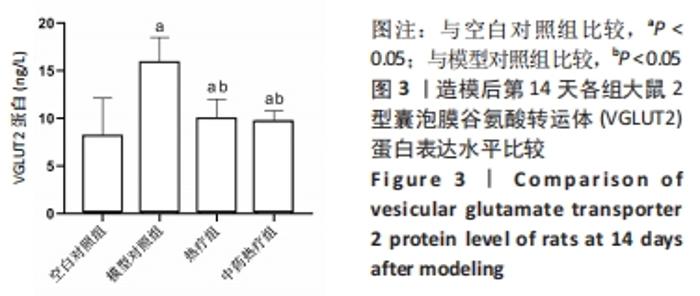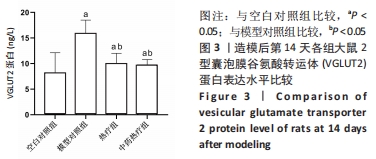Chinese Journal of Tissue Engineering Research ›› 2022, Vol. 26 ›› Issue (26): 4199-4204.doi: 10.12307/2022.824
Previous Articles Next Articles
Analgesic effect and mechanism of pivot meridian hyperthermia in a rat model of neuropathological pain
Qin Qin, Xia Tian, Li Yuefa, Zhang Lingling, Qin Haixia
- Guangxi University of Chinese Medicine, Nanning 530023, Guangxi Zhuang Autonomous Region, China
-
Received:2021-09-30Accepted:2021-12-03Online:2022-09-18Published:2022-03-08 -
Contact:Xia Tian, MD candidate, Associate professor, Guangxi University of Chinese Medicine, Nanning 530023, Guangxi Zhuang Autonomous Region, China -
About author:Qin Qin, Master, Associate chief nurse, Guangxi University of Chinese Medicine, Nanning 530023, Guangxi Zhuang Autonomous Region, China -
Supported by:the Youth Science Fund of Guangxi Zhuang Autonomous Region Science and Technology Department, No. QJJ18003 (to XT)
CLC Number:
Cite this article
Qin Qin, Xia Tian, Li Yuefa, Zhang Lingling, Qin Haixia. Analgesic effect and mechanism of pivot meridian hyperthermia in a rat model of neuropathological pain[J]. Chinese Journal of Tissue Engineering Research, 2022, 26(26): 4199-4204.
share this article
Add to citation manager EndNote|Reference Manager|ProCite|BibTeX|RefWorks
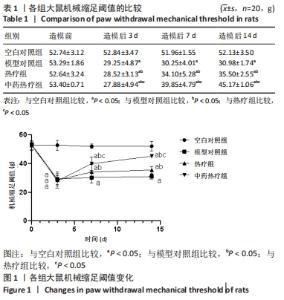
2.1 实验动物数量分析 实验共纳入SD大鼠80只,分为4组,全部进入结果分析,未发生脱失情况。 2.2 各组大鼠行为学情况 2.2.1 各组大鼠机械缩足阈值的比较 在每组大鼠造模之前,机械缩足阈值比较差异无显著性意义(P > 0.05),表明具有可比性。在造模后第3,7,14天,模型对照组、热疗组、中药热疗组与空白对照组大鼠机械缩足阈值比较差异均有显著性意义(P < 0.05),表明造模导致模型对照组、热疗组、中药热疗组大鼠的机械缩足阈值降低,且低于空白对照组。在造模后的第3天,中药热疗组与模型对照组、热疗组大鼠机械缩足阈值比较差异无显著性意义(P > 0.05)。造模后第7,14天,热疗组和中药热疗组与模型对照组大鼠机械缩足阈值比较差异有显著性意义(P < 0.05),表明枢经热疗第7,14天后中药热疗组大鼠机械缩足阈值明显高于模型对照组和热疗组。造模后7 d以上,中药热疗组与热疗组大鼠机械缩足阈值比较差异有显著性意义(P < 0.05),表明在7 d以上的中药枢经热疗后,中药热疗组大鼠机械缩足阈值明显高于热疗组,结果见表1及图1。"
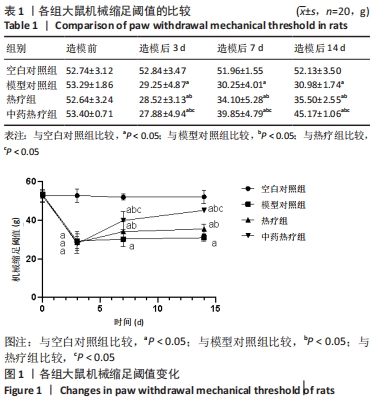
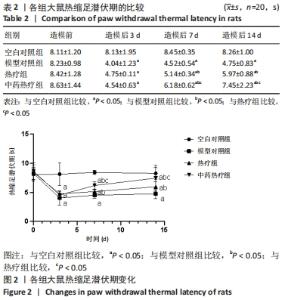
2.2.2 各组大鼠热缩足潜伏期的比较 在每组大鼠造模之前,热缩足潜伏期比较差异无显著性意义(P > 0.05),表明具有可比性。在造模后第3,7,14天,模型对照组、热疗组、中药热疗组分别与空白对照组大鼠热缩足潜伏期比较差异均有显著性意义(P < 0.05),表明造模导致模型对照组、热疗组、中药热疗组大鼠的热缩足潜伏期缩短,且小于空白对照组。在造模后的第3天,中药热疗组与模型对照组、热疗组大鼠热缩足潜伏期比较差异无显著性意义(P > 0.05)。造模后第7,14天,热疗组和中药热疗组与模型对照组大鼠之间热缩足潜伏期比较差异有显著性意义(P < 0.05),表明在7 d以上的中药枢经热疗后,中药热疗组大鼠热缩足潜伏期明显长于模型对照组和热疗组。造模后第7,14天,中药热疗组与热疗组大鼠之间热缩足潜伏期比较差异有显著性意义(P < 0.05),表明在7 d以上的中药枢经热疗后,中药热疗组大鼠热缩足潜伏期明显长于热疗组,结果见表2及图2。"
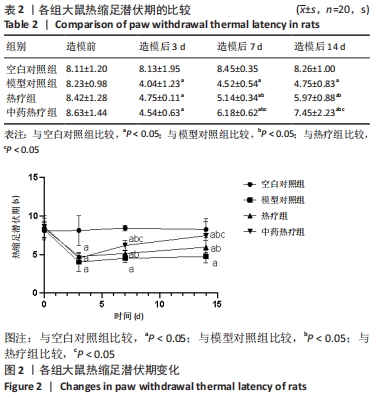

2.3 各组大鼠脊髓组织中VGLUT2/TLR4信号通路相关蛋白表达情况 2.3.1 各组大鼠脊髓组织中VGLUT2蛋白表达水平比较 造模后第14天,模型对照组、热疗组、中药热疗组与空白对照组VGLUT2蛋白表达水平比较差异均有显著性意义(P < 0.05),表明造模后,模型对照组、热疗组、中药热疗组的VGLUT2蛋白表达水平出现显著变化;热疗组、中药热疗组与模型对照组VGLUT2蛋白表达水平比较差异有显著性意义(P < 0.05),表明枢经热疗14 d后,热疗组和中药热疗组的VGLUT2蛋白表达水平均显著低于模型对照组;中药热疗组与热疗组比较差异无显著性意义(P > 0.05),结果见表3及图3。"

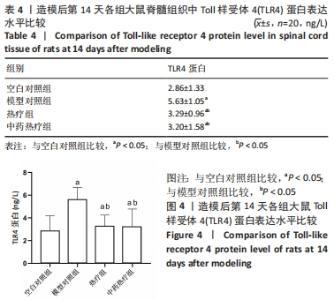
2.3 各组大鼠脊髓组织中VGLUT2/TLR4信号通路相关蛋白表达情况 2.3.1 各组大鼠脊髓组织中VGLUT2蛋白表达水平比较 造模后第14天,模型对照组、热疗组、中药热疗组与空白对照组VGLUT2蛋白表达水平比较差异均有显著性意义(P < 0.05),表明造模后,模型对照组、热疗组、中药热疗组的VGLUT2蛋白表达水平出现显著变化;热疗组、中药热疗组与模型对照组VGLUT2蛋白表达水平比较差异有显著性意义(P < 0.05),表明枢经热疗14 d后,热疗组和中药热疗组的VGLUT2蛋白表达水平均显著低于模型对照组;中药热疗组与热疗组比较差异无显著性意义(P > 0.05),结果见表3及图3。 2.3.2 各组大鼠脊髓组织中TLR4蛋白表达水平比较 造模后第14天,模型对照组、热疗组、中药热疗组分别与空白对照组TLR4蛋白表达水平比较差异均有显著性意义(P < 0.05),表明造模后,模型对照组、热疗组、中药热疗组的TLR4蛋白表达水平出现显著变化;热疗组、中药热疗组与模型对照组TLR4蛋白表达水平比较差异有显著性意义(P < 0.05),表明枢经热疗14 d后,热疗组和中药热疗组的TLR4蛋白表达水平均显著降低,且低于模型对照组;中药热疗组与热疗组比较差异无显著性意义(P > 0.05),结果见表4及图4。"
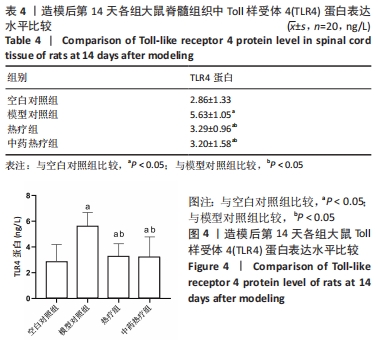
| [1] SADOSKY A, SCHAEFER C, MANN R, et al. Burden of illness associated with painful diabetic peripheral neuropathy among adults seeking treatment in the us: Results from a retrospective chart review and cross-sectional survey. Diabetes Metab Syndr Obes. 2013;6:79-92. [2] SCHAEFER C, MANN R, SADOSKY A, et al. Burden of illness associated with peripheral and central neuropathic pain among adults seeking treatment in the united states: A patient-centered evaluation. Pain Med. 2014;15(12):2105-2119. [3] ZHAO L, CHEN J, LI Y, et al. The long-term effect of acupuncture for migraine prophylaxis-A randomized clinical trial. JAMA Intern Med. 2017;177(4):508-515. [4] SHINY ES, SAFREENA I. Assess the effectiveness of foot and hand massage on caesarean pain among post-natal mothers. J Obstetr Gynaecol Nursing. 2021; 9(2):26-32. [5] 庞军,杨鹏,卢栋明,等. 枢经推拿治疗腰椎间盘突出症的临床疗效及对患者病变区域红外热成像的影响[J].广西医学,2021,43(16): 1909-1912. [6] CHO YS, KO HG, HAN HM, et al. Vesicular glutamate transporter-immunopositive axons that coexpress neuropeptides in the rat and human dental pulp. Int Endod J. 2021;54(3):377-387. [7] ZENG X, NIU Y, QIN G, et al. Deficiency in the function of inhibitory interneurons contributes to glutamate-associated central sensitization through GABABR2-SynCAM1 signaling in chronic migraine rats. FASEB J. 2020;34(11): 14780-14798. [8] GAO YH, WANG JY, HAN YJ, et al. Spinal cord Toll like receptor 4 and its co-stimulatory molecule heat shock protein 90 may parti-cipate in electroacupuncture analgesia in rats with chronic neuropathic pain. Zhen Ci Yan Jiu. 2021;46(9):735-741. [9] DAI GG, WANG Y, LIAO SC, et al. Characteristics and Significance of Gene Expression Changes in Peripheral Blood of Lumbar Disc Extrusion Patients before and after Nonoperative Treatment. Sichuan Da Xue Xue Bao Yi Xue Ban. 2021;52(5):868-876. [10] KIM SH, CHUNG JM. An experimental model for peripheral neuropathy produced by segmental spinal nerve ligation in the rat. Pain. 1992; 50(3):355-363. [11] 庞军.枢经学说的理论和应用研究[D].武汉:湖北中医药大学,2010. [12] 吴金玉,黄仁发,史伟,黄雪霞,覃祚莲.田七注射液对2-4期慢性肾脏病患者微炎症状态及免疫功能的影响[J].广西医学,2012,34(3): 260-263. [13] 罗翠萍,孙钰,耿猛.分经辨治针刺结合中药热敷治疗神经根型颈椎病的疗效观察[J].中华针灸电子杂志,2019,8(3):92-95. [14] 宋学军.疼痛信号外周神经转导的分子生物学机制[J].中国疼痛医学杂志,2016,22(1):2-7. [15] OH JY, HWANG TY, JANG JH, et al. Muscovite nanoparticles mitigate neuropathic pain by modulating the inflammatory response and neuroglial activation in the spinal cord. Neural Regen Res. 2020;15(11): 2162-2168. [16] LEO S, MOECHARS D, CALLAERTS-VEGH Z, et al. Impairment of VGLUT2 but not VGLUT1 signaling reduces neuropathy-induced hypersensitivity. Eur J Pain. 2009; 13(10):1008-1017. [17] DRAXLER P, HONSEK SD, FORSTHUBER L, et al. VGluT3(+) primary afferents play distinct roles in mechanical and cold hypersensitivity depending on pain etiology. J Neurosci. 2014; 34(36):12015-12028. [18] SEAL RP, WANG X, GUAN Y, et al. Injury-induced mechanical hypersensitivity requires C-low threshold mechanoreceptors. Nature. 2009;462(7273):651-655. [19] LIU Y, ABDEL SO, ZHANG L. VGLUT2-dependent glutamate release from nociceptors is required to sense pain and suppress itch. Neuron. 2010; 68(3):543-556. [20] BRUMOVSKY P, WATANABE M, HOKFELT T. Expression of the vesicular glutamate transporters-1 and -2 in adult mouse dorsal root ganglia and spinal cord and their regulation by nerveinjury. Neuroscience. 2007; 147(2):469-490. [21] MOECHARS D, WESTON MC, LEO S, et al. Vesicular glutamate transporter VGLUT2 expression levels control quantal size and neuropathic pain. J Neurosci. 2006;26(46):12055-12066. [22] SANTOS MS, LI H, VOGLMAIER SM. Synaptic vesicle protein trafficking at the glutamate synapse. Neuroscience. 2009; 158(1):189-203. [23] ZHANG FX, GE SN, DONG YL, et al. Vesicular glutamate transporter isoforms: The essential players in the somatosensory systems. Prog Neurobiol. 2018;171:72-89. [24] GU P, PAN Z, WANG XM, et al. Histone deacetylase 5(HDAC5) regulates neuropathic pain through SRY-related HMG-box 10(SOX10)-dependent mechanism in mice. Pain. 2018;159(3):526-539. [25] MALET M, BRUMOVSKY PR. VGLUTs and glutamate synthesis-focus on DRG neurons and pain. Biomolecules. 2015;5(4):3416-3437. [26] WANG ZT, YU G, WANG HS, et al. Changes in VGLUT2 expression and function in pain-related supraspinal regions correlate with the pathogenesis of neuropathic pain in a mouse spared nerve injury model. Brain Res. 2015;1624:515-524. [27] SCHERRER G, LOW SA, WANG X, et al. VGLUT2 expression in primary afferent neurons is essential for normal acute pain and injury-induced heat hypersensitivity. Proc Natl Acad Sci USA. 2010;107(51):22296-222301. [28] LI Q. Antagonists of toll like receptor 4 maybe a new strategy to counteract opioid-induced hyperalgesia and opioid tolerance. Med Hypotheses. 2012;79(6):754-756. [29] PLOCIENNIKOWSKA A, HROMADA-JUDYCKA A, BORZECKA K. Co-operation of TLR4 and raft proteins in LPS-induced pro-inflammatory signaling. Cell Mol Life Sci. 2015;72(3):557-581. [30] ZALI H, GOLCHIN A, FARAHANI M. FDA Approved Drugs Repurposing of Toll-Like Receptor4 (TLR4) Candidate for Neuropathy. Iran J Pharm Res. Summer. 2019;18(3):1639-1647. [31] 张姗姗,刘漫,刘冬妮,等.TLR4-IN-C34通过抑制TLR4/MyD88/NF-κB/NLRP3信号通路减轻脂多糖诱导的BV2小胶质细胞炎症反应[J].中国药理学与毒理学杂志,2021,35(10):804. [32] WANG LT, WANG SJ, HSU SH. Functional characterization of mammalian Wntless homolog in mammalian system. Kaohsiung J Med Sci. 2012; 28(7):355-361. [33] WANG X, LORAM LC, RAMOS K, et al. Morphine activates neuroinflammation in a manner parallel to endotoxin. Proc Natl Acad Sci U S A . 2012;109(16):6325-6330. [34] FRANCHI S, MORETTI S, CASTELLI M, et al. Mu opioid receptor activation modulates Toll like receptor 4 in murine macrophages. Brain Behav Immun. 2012;26(3):480-488. [35] LEE JW, NAM H, KIM LE, et al. TLR4 (toll-like receptor 4) activation suppresses autophagy through inhibition of FOXO3 and impairs phagocytic capacity of microglia. Autophagy. 2019;15(5):753-770. [36] VICHAYA EG, FORD BG, QUAVE CB, et al. Toll-like receptor 4 mediates the development of fatigue in the murine Lewis Lung Carcinoma model independently of activation of macrophages and microglia. Psychoneuroendocrinology. 2020;122:104874. [37] JIN R, LIU L, ZHU W, et al. Iron oxide nanoparticles promote macrophage autophagy and inflammatory response through activation of toll-like Receptor-4 signaling. Biomaterials. 2019;203:23-30. [38] LIU Z, MA Y, CUI Q, et al . Toll-like receptor 4 plays a key role in advanced glycation end products-induced M1 macrophage polarization. Biochem Biophys Res Commun. 2020;531(4):602-608. |
| [1] | Wang Jianping, Zhang Xiaohui, Yu Jinwei, Wei Shaoliang, Zhang Xinmin, Xu Xingxin, Qu Haijun. Application of knee joint motion analysis in machanism based on three-dimensional image registration and coordinate transformation [J]. Chinese Journal of Tissue Engineering Research, 2022, 26(在线): 1-5. |
| [2] | Jing Jinpeng, Zhang Yue, Liu Xiaomin, Liu Yi. Traditional Chinese medicine injection for promoting blood circulation in prevention of deep vein thrombosis after orthopedic surgery: network meta-analysis [J]. Chinese Journal of Tissue Engineering Research, 2022, 26(9): 1467-1476. |
| [3] | Li Huo, Wang Peng, Gao Jianming, Jiang Haoran, Lu Xiaobo, Peng Jiang. Relationship between revascularization and internal microstructure changes in osteonecrosis of the femoral head [J]. Chinese Journal of Tissue Engineering Research, 2022, 26(9): 1323-1328. |
| [4] | Bao Xianguo, Gao Zengxin, Wu Zhanpo, Chen Youmin, Cheng Qinghua, Lu Haitao, Guo Changzheng, Xu Shuai. Correlation between lumbar posterior muscle and local kyphosis in patients with degenerative thoracolumbar kyphosis [J]. Chinese Journal of Tissue Engineering Research, 2022, 26(9): 1418-1423. |
| [5] | Zhang Haobo, Zhao Yunan, Yang Xuejun. Role and therapeutic implications of pyroptosis in intervertebral disc degeneration [J]. Chinese Journal of Tissue Engineering Research, 2022, 26(9): 1445-1451. |
| [6] | Zhu Chan, Han Xuke, Yao Chengjiao, Zhang Qiang, Liu Jing, Shao Ming. Acupuncture for Parkinson’s disease: an insight into the action mechanism in animal experiments [J]. Chinese Journal of Tissue Engineering Research, 2022, 26(8): 1272-1277. |
| [7] | Gu Zhengqiu, Xu Fei, Wei Jia, Zou Yongdi, Wang Xiaolu, Li Yongming. Exploratory study on talk test as a measure of intensity in blood flow restriction training [J]. Chinese Journal of Tissue Engineering Research, 2022, 26(8): 1154-1159. |
| [8] | Kong Yamin, Yan Juntao, Ma Bingxiang, Li Huawei. Massage vibration intervenes with MyoD expression and proliferation and differentiation of muscle satellite cells in rats with sciatic nerve injury [J]. Chinese Journal of Tissue Engineering Research, 2022, 26(8): 1160-1166. |
| [9] | Wu Cong, Jia Quanzhong, Liu Lun. Relationship between transforming growth factor beta1 expression and chondrocyte migration in adult articular cartilage after fragmentation [J]. Chinese Journal of Tissue Engineering Research, 2022, 26(8): 1167-1172. |
| [10] | Li Zhiyi, He Pengcheng, Bian Tianyue, Xiao Yuxia, Gao Lu, Liu Huasheng. Bibliometric and visualized analysis of ferroptosis mechanism research [J]. Chinese Journal of Tissue Engineering Research, 2022, 26(8): 1202-1209. |
| [11] | Xiang Xinjian, Liu Fang, Wu Liangliang, Jia Daping, Tao Yue, Zhao Zhengnan, Zhao Yu. High-dose vitamin C promotes the survival of autologous fat transplantation in rats [J]. Chinese Journal of Tissue Engineering Research, 2022, 26(8): 1242-1246. |
| [12] | Tian Chuan, Zhu Xiangqing, Yang Zailing, Yan Donghai, Li Ye, Wang Yanying, Yang Yukun, He Jie, Lü Guanke, Cai Xuemin, Shu Liping, He Zhixu, Pan Xinghua. Bone marrow mesenchymal stem cells regulate ovarian aging in macaques [J]. Chinese Journal of Tissue Engineering Research, 2022, 26(7): 985-991. |
| [13] | Wang Jifang, Bao Zhen, Qiao Yahong. miR-206 regulates EVI1 gene expression and cell biological behavior in stem cells of small cell lung cancer [J]. Chinese Journal of Tissue Engineering Research, 2022, 26(7): 1027-1031. |
| [14] | Zhu Bingbing, Deng Jianghua, Chen Jingjing, Mu Xiaoling. Interleukin-8 receptor enhances the migration and adhesion of umbilical cord mesenchymal stem cells to injured endothelium [J]. Chinese Journal of Tissue Engineering Research, 2022, 26(7): 1045-1050. |
| [15] | Wen Xiaoyu, Sun Yuhao, Xia Meng. Effects of serum containing Wuzang Wenyang Huayu Decoction on phosphorylated-tau protein expression in Alzheimer’s disease cell model [J]. Chinese Journal of Tissue Engineering Research, 2022, 26(7): 1068-1073. |
| Viewed | ||||||
|
Full text |
|
|||||
|
Abstract |
|
|||||
